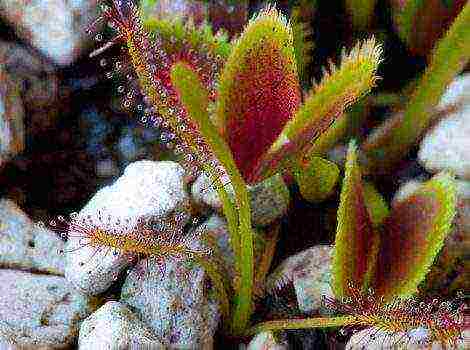Content
- 1 Composition of the earth and the choice of capacity
- 2 Lighting and temperature control
- 3 Watering and humidity
- 4 Top dressing and fertilizers
- 5 Diseases and pests
- 6 Some valuable tips
- 7 Video: how to easily and quickly propagate Benjamin's ficus
- 8 The necessary conditions
- 9 Temperature and lighting
- 10 Substrate selection and root care
In the fall, leaves turn yellow and fall not only on trees on the street, but also on indoor plants. Ficus leaves are particularly affected. If such a leaf fall occurs more often than once a year, then the owners have something to think about.
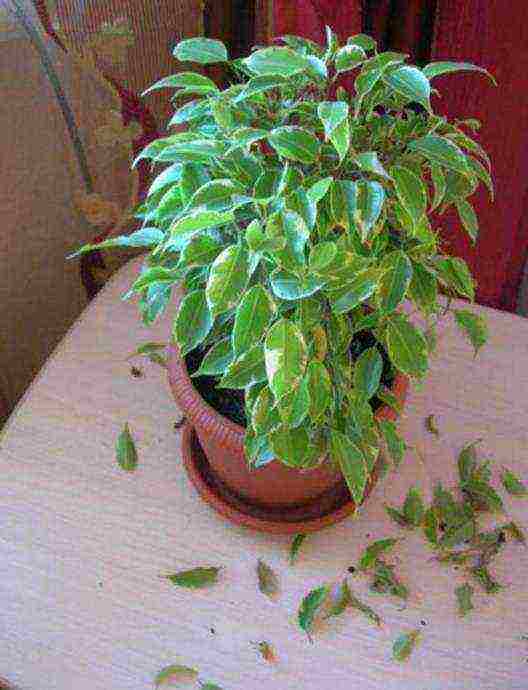
In ficus Benjamin and other small-leaved species, slight loss of leaves in the fall and even winter months is considered normal. It is easy to find out if everything is in order with the green "pet": if the number of fallen leaves is no more than 10 - 15, then there is no reason to worry - in spring young leaves will grow in these places.
But if a lot of leaves have fallen in winter, then you should pay attention to the conditions in which the plant is kept.
We are used to hearing the word "stress" in relation to people, but all sorts of cataclysms also happen in plant life. The condition of ficus is adversely affected by:
- moving to a new place (for example, after purchase), rearranging the flower pot in the apartment;
- being in a draft, in the cold;
- transplanting into a new pot;
- lack of sunshine;
- excessive watering.
Watering should be sufficient, but not excessive. Ficus is watered only when the soil in the pot is completely dry. If the substrate under the ficus is wet the next day after watering, you need to drain the excess water from the pan and water the ficus less often. When the soil is waterlogged, only transplanting into a fresh substrate will help.
Often the leaves of ficuses turn yellow from the cold. Ficus needs a bright, draft-free place to feel good. The tops of the shoots must be in the light. The best temperature is 18 - 20 ° C. If you still have to keep the plant on a cold windowsill, you need to put felt, polystyrene under the pot.
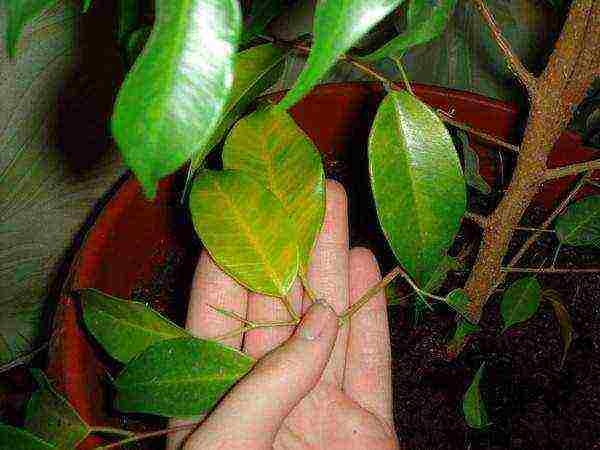
The answer to the question of why leaves fall off of a ficus can be as trivial as the appearance of pests. These plants are often affected by scale insects, mealybugs, spider mites.
Special sprayers will be able to help the ficus grow with new leaves as soon as possible. The most famous drug in this group is EPIN. It is an aerosol intended for the resuscitation of indoor plants. You need 2 drops of EPIN per glass of water. Ficus is sprayed once a week.
A prerequisite: the ficus should be treated with this drug in the dark. In the light, the properties of active substances are destroyed, the diluted mixture begins to deteriorate. The course of treatment with EPIN is 7 days. After a week of rest, you can carry out another course if necessary.
It also happens that all of the above measures do not work - the leaves continue to fall off. The reason in this case may be rotten roots. Remove the plant from the pot, carefully clean the roots of any clods of soil. If some of them became slippery, turned into gray threads, the diagnosis was confirmed. Such a damaged plant needs to be transplanted into new soil.
You must first cut off all rotten root areas. Soft and dry remnants of dead leaves must also be removed. Then the root system is soaked for disinfection in a slightly pink solution of potassium permanganate. The cut is dried and covered with gruel of foundation, ground cinnamon, coal powder. To transplant, you need dry soil. Watering the transplanted ficus is necessary for the first week very moderately. Leaves can be wiped clean with a damp cotton cloth.
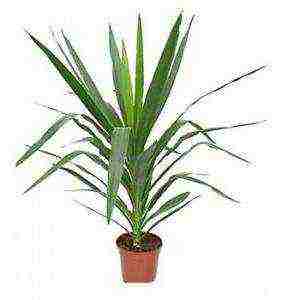
Indoor flower Yucca is an evergreen, woody plant. Yucca is native to North America and has nearly 40 species of subtropical tree-like perennial plants of the agave family.
The stem of the yucca is low and slightly branched. Moreover, in some species it may be practically absent and only a bunch of large leaves, xiphoid, located in a spiral, rises above the soil.
Large inflorescences (up to 2 meters long) are erect and widely spreading panicles growing from the middle of the leaf rosette. The flowers themselves are bell-shaped, drooping, white. The fruits of the plant look like a fleshy or dry box, about 10 cm, inside which there are black round seeds up to 1 cm in diameter.
Yucca is a rather unpretentious houseplant and does not cause trouble to care for it. It grows long enough, thereby retaining its decorative appearance for a long time.
Reproduction at home
Yucca propagation can be done in different ways.
- Seeds. To propagate a home flower in this way, fresh seeds are needed. They must be soaked in water for a day and then sown into the soil, which should consist of peat and leafy soil.
The pot should be covered with a transparent bag or glass, remembering to ventilate periodically throughout the day. Seeds germinate within a month, after which it is not required to cover the young shoots.
- Rooting the top of the stem. In the spring, a houseplant can be rooted by cutting off a stalk at least 10 cm long from the yucca trunk.First, it must be dried for 1-2 hours, and then planted in a slightly moistened mixture of sand and peat and put in a shaded place.
Also, you can put yucca cuttings for rooting in water, adding crushed activated carbon there. In this case, care must be taken that the lower leaves of the flower are not in the water. During rooting, they can begin to rot, which will lead to rotting of the trunk.
When the stalk has released the roots, it can be transplanted into the substrate. With this type of propagation, to prevent large evaporation of moisture, the cuttings should also be covered with glass or transparent film.
- Trunk sections. For reproduction in this way, in the spring, part of the bare trunk of the plant is cut off and placed horizontally in a pot of wet sand. The trunk should be lightly pressed into the sand. The dormant buds on the trunk of the plant will wake up after a while and give shoots with roots. After that, the trunk is divided with a sharp knife and each shoot is planted in a separate pot.
- Root offspring. This method is the easiest. In spring or summer, the offspring are separated from the mother plant with a sharp knife and take root in wet sand.
How to properly transplant a yucca
Usually, yucca is transplanted in the spring, every 2 years. The soil mixture should be nutritious and consist of clay-sod land, humus, river sand and peat in a ratio of 2: 2: 1: 1. The plant will need a large pot or tub and good drainage.
How to properly prune a yucca
If you do not cut the flower, then over time it will look like a palm tree - a long trunk, from the top of which leaves grow. But it can be shaped in such a way that the plant branches out.
For this purpose, in spring or early summer, the top of the yucca should be cut off, leaving at least 30 cm of its height. In this case, part of the leaves should also be left. Sprinkle the slices with crushed charcoal. Over time, the yucca will release young shoots.
Correct feeding and fertilization of yucca
It is necessary to feed the plant with a weak solution of mineral fertilizers once every 2-3 weeks from spring to the end of summer, during the active growing season. An infusion of horse manure, mullein and leaf humus is also well suited for this purpose.
Shown and outside root dressing in the form of spraying with a weakly diluted composition of mineral fertilizers plant leaves on the lower side. You should not fertilize the yucca immediately after transplanting or if it is sick.
How to water a yucca
This plant does not require frequent watering. The soil should be kept moderately moist from spring to autumn. To do this, it is enough to water once a week. But it is necessary to ensure that no water remains in the pan - this can lead to rotting of the stem and roots.
It is better to dry the yucca than to pour it over, since the loose trunk of the plant is able to retain the accumulated moisture for a long time. In winter, it is necessary to reduce the number of watering to once every 10 days, while not allowing the earthen coma to dry out.
In summer, additional spraying is not required for yucca, but sometimes the leaves should be washed to maintain the decorative effect of the plant. In winter, if the plant is kept in a room with dry, hot air in the presence of central heating, it is advisable to spray the yucca once a day.
It is necessary to observe a moderate temperature regime: in the spring-summer period - 20-25 ° C, in winter - 16-18 ° C. The plant does not tolerate temperatures below 8 ° C. It is also necessary to periodically ventilate the room, avoiding drafts.
If there is a high temperature in the room in winter and insufficient illumination, then this can lead to the overgrowth of yucca: the shoots at the base are strongly elongated, the leaves turn pale, thinner and hang down ugly.
The flower prefers bright and sunny places, but it should be protected from direct sunlight. The most optimal place for a yucca will be west or east windows. In the summer, it is better to place the yucca outdoors - in the garden or on the balcony.
In winter, it is advisable to place the plant closer to the window, otherwise the fan of leaves from a lack of lighting will become not so thick and lush. With a lack of natural light, the plant needs additional artificial lighting for 16 hours a day.
Why do the lower leaves turn yellow? If you notice that the lower leaves are slowly starting to turn yellow, do not be alarmed - this is a natural process. Yucca leaves live for about 2 years, and then turn yellow and die off.
Why is it dropping leaves? Changing the conditions of yucca maintenance (acquisition or transplantation) may cause the plant to shed some of the lower leaves. If a large number of leaves fall, then this is possibly the result of hypothermia or drafts.
Why do leaves dry? The tips and edges of the yucca leaves begin to dry from the dry indoor air. Most species of this plant require increased air humidity. Also, the reasons may be insufficient watering or drafts.
Why do the leaves curl? The leaves of the plant can become soft and curled as a result of the sudden drop in temperature.
Why do leaf spots appear? Insufficient watering of the plant can be the reason for the appearance of brown spots. Light dry spots appear from direct sunlight.
A greyish-brown spot on the leaves occurs as a result of fungal infection, which is facilitated by increased soil or air humidity. To combat the fungus, the affected leaves must be removed, sprayed with the fungicide and reduced watering and spraying.
Why does the plant have spots on the trunk? Dark spots and softened areas on the trunk are formed as a result of abundant watering in winter, or low indoor temperatures.
This process threatens the death of the plant. If there are several elastic leaves and part of the trunk is light in color and hard to the touch, then you can try to save the plant and grow new roots from the yucca.
Why doesn't it bloom? As a rule, mature plants bloom. Usually, with proper care, this happens for 5-7 years.
Today, undeservedly forgotten ficuses are again at the height of fashion among flower growers.But there was a time when this unpretentious plant was in every home. Caring for it is minimal, but the return in the form of lush foliage is beyond praise!
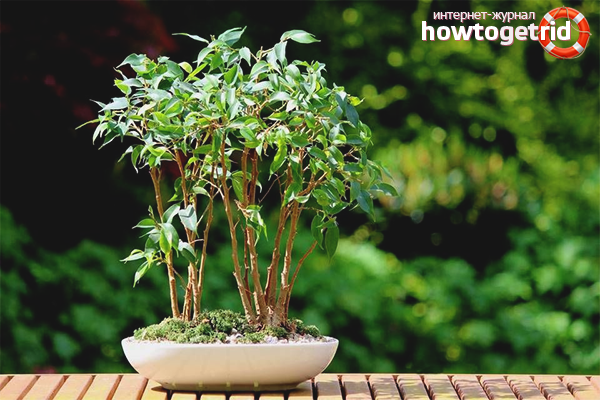
The current selection offers such variegated forms that it is a sin not to have such beauty on the windowsill. How to care for ficus at home? In principle, not very difficult. Let's describe the most important aspects. If you follow them, caring for the ficus will not bring unnecessary trouble.
Composition of the earth and the choice of capacity
The material of the pot is absolutely irrelevant for the ficus, but its size is even very important. Do not plant the plant in too large a container, otherwise it will become a little insolent. And it grows up to a very decent size, because in natural conditions their height reaches 5 meters. Although, if your area allows, then feel free to grow ficus in a huge tub. He will thank you with huge leaves.
The composition of the soil is absolutely standard. 2 parts of good fertile garden soil are mixed with 1 part peat and 1 part clean coarse sand. That's it, nothing else needs to be added.
Naturally, a drainage layer is poured onto the bottom of the pot. Probably, this rule applies to absolutely all indoor flowers. Small expanded clay, small pebbles or gravel, granite chips - these are the most suitable materials. You should not neglect this point, because it helps to solve many problems. For example, the main function of removing excess moisture will prevent root rot and the appearance of various diseases.
how to grow geraniums at home
Lighting and temperature control
Ficuses love light. But not completely insane. Therefore, it is better to grow it in light shade, without direct sunlight. You can put the pot on a stand next to the window, but not on the windowsill. This light will be enough.
Ficus will grow well in the back of the room, without access to sunlight. In this case, additional supplementary lighting with special phytolamps is required.
The temperature of the content varies depending on the season. In summer, ficus will be most comfortable at + 24-26 ° С. In winter, he prefers + 17-19 ° С.
In principle, ficus easily tolerates a temporary decrease in temperature. The only thing is that at this time he slows down in growth. A drop to + 12 ° C is critical for the plant. Then it will simply throw off all the leaves and gather to say goodbye to you.
how to grow begonia
Watering and humidity
Ficuses love high humidity. Therefore, they need to be regularly sprayed with slightly warm water. Or put additional containers with water, wet expanded clay, wet moss next to the pot.
After drying, stains may remain on the leaves. This is from too hard water. If the liquid is settled, filtered or purified, then there will be no stains. Another reason is dust on the surface of the sheet. About once every 12-13 days, wipe the leaves with a soft cloth or rag. Then dust will not accumulate, so you can forget about stains.
Watering should be regular. In the summer, it is recommended to keep the entire earthen lump in a slightly damp state. To do this, it is regularly moistened from above. Approximately every 3-4 days. Critical drying occurs when the top layer of earth in the pot dries out to a depth of 3-3.5 cm. In this case, expect a violent leaf fall.
When overflowing, the first sign is wilting and wrinkling of the leaves. The second is incipient root rot. Watch this. It is better to water often and little by little than to splash a liter mug into the pot once a month.
In winter, ficus is watered much less often. Approximately every 10-11 days. Again, you need to look at the moisture content of the soil. If in the cold season you keep the plant in a hot, dry room or next to a heating device, then you should reconsider the watering regime, for example, increase it more often.
Special beacons will provide a good service. They are stuck into the soil and watched over the scale. When the earth dries up at a certain level, it will change color.This will be the signal for watering.
how to grow a date palm from seed
Top dressing and fertilizers
Starting in March and ending in October, the ficus is fertilized about once every 14-16 days. Certainly only after the next watering, so as not to burn the thin young roots. You can use any complex mineral fertilizer for feeding. Or buy ready-made sticks in a specialty store. They are stuck in a pot and after each watering, the ficus will take as much food as it needs. Granules (tablets) have the same property. They are also buried in the topsoil.
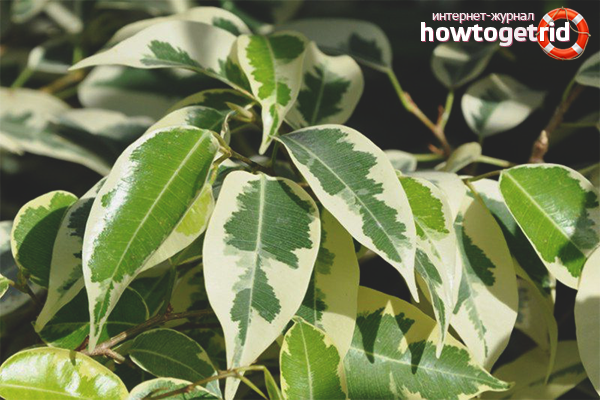
Just follow the dosage strictly! Do not exceed it, otherwise the ficus will begin to grow ugly deformed leaves. And choose those on the packaging which says "for ficus".
The plant reacts much more gratefully to organic goodies. It can be a herbal infusion, diluted in a ratio of 1 to 10. Or, once a year, replace the top 2-2.5 cm of soil with fresh, well-ripened humus. Just do not overdo it, otherwise the trunk simply will not withstand the entire mass of its leaves and may break.
Diseases and pests
Most pests of indoor plants are indifferent to ficus, except for the spider mite and scale insects. In this case, you will have to use insecticides. Choose any one that says "suitable for indoor flowers" on the packaging. Processing is always done twice, because once is not enough for the complete destruction of enemies.
If you are an opponent of chemicals, then you can try to thoroughly rinse the leaves and stem with a strong solution of household or potassium soap. Only be sure to then rinse the plant with warm water to remove the remaining foam. Be sure to cover the potting soil with thick plastic or cling film.
Among the sores, ficuses have chosen various rot. If the leaves are affected, then at the initial stage it is enough to wash them with soapy water. With a large degree of damage, it is better to remove the diseased leaves completely.
Root rot can destroy even the most lush plant in a matter of days. There are no cure methods for it yet. You can only have time to cut as many healthy cuttings as possible and try to root them.
The causes of rot are excessive watering, drafts and a sharp drop in temperature. By eliminating these factors, you can avoid plant disease completely.
how to grow cyclamen from seeds
Some valuable tips

- Ficuses really do not like to be disturbed. This includes transplanting, changing locations, and even turning the pot. We chose a container, planted a plant and that's it. Don't touch it again. Do not move to another place, do not turn the pot its other side to the light. No unnecessary touches other than the standard wiping of the leaves during hygienic care.
- Sometimes the owners want to have a compact fluffy ficus bush, and a lone stick sticks out in the pot. And it grows not wide, but into the ceiling. Stop. And who said that ficuses should not be pinched for better branching? We wipe the blade or knife with alcohol, carefully cut off the trunk at the desired height. The cut is processed with a finely crushed tablet of activated carbon. And we are waiting for the side shoots to appear. In turn, they can also be trimmed. Then shoots of the third order will begin to grow. And now you already have a coveted lush bush with gorgeous leaves.
- We do not discard the cut off top. We put it in a glass of water. We wait two weeks for the roots, then we put them in a suitable pot in the right place.
- Some owners do wonders at all. Three plants are grown in a pot at the same time to about a height of 1 m. Then the tops are pinched, and the stems themselves are braided into a loose pigtail. Thanks to its flexibility, this is very easy to do. But after the appearance of lateral shoots, an exclusive figure with a magnificent cap on the top of the head is obtained. It looks very impressive, and the care is absolutely identical to the care of a single plant.
- In autumn and winter, ficus can shed a few lower leaves. Do not rush to look for the cause in improper care or maintenance. This is a completely natural process. The alarm should be beaten when leaf fall begins in spring or summer, and also takes on the threatening nature of the loss of the entire leaf cover.
How to care for ficus at home? Our grandmothers perfectly knew all the subtleties and secrets of the content. It's time for us to revive ficuses in every home. Moreover, it is not difficult at all. A few correct recommendations and a love for the plant - that's all you need for quality care.
how to grow violets correctly
Video: how to easily and quickly propagate Benjamin's ficus
Phalaenopsis conquered the hearts of many flower growers, this is a flower of unique beauty, with proper care it blooms extensively and for a long time. The flowering time of an orchid is about 2 months, it can be repeated 2-3 times a year.

Orchid flowering period at home
Blooming at home
For flowering, the orchid requires special conditions of detention. Each variety has its own requirements for home care and its own flowering time.
A flower younger than 1.5 years does not bloom, it lacks the strength to release a peduncle. By 1.5-2 years, the plant should have formed at least 6 leaves.
Orchid flowering time is 6 months. The life of flowers is no more than 3 months, and they are replaced during the flowering process. The plant does not have a clearly defined dormant period and is not tied to the season.
The necessary conditions
Orchids bloom from 3 to 6 months a year. Factors influencing the growing season and the number of flowers:
- temperature regime;
- lighting;
- watering and moisture;
- flower age;
- root system care;
- stress from transplant or illness.
The vegetation of flowers often takes place in the summer, the peduncle climbs in the fall, and the orchid blooms by winter. It happens that the plant produces a second peduncle in the spring, and it blooms in the summer.
Temperature and lighting
Orchids should bloom several times a year at a temperature of 25 ° C during the day, up to 18 ° C at night.
In the summer, take the plant pot out to the balcony, do not keep it in a stuffy box. Protect phalaenopsis from direct sunlight and avoid drafts. Orchids bloom only if there is a temperature difference.
The flower is comfortable on the eastern windowsill in the warm season, and on the south in the cold. In the cold season, the daylight hours are short, so in the evening they use a fluorescent lamp, it is worth highlighting the very top, otherwise it will not form and bloom.
Substrate selection and root care
Suitable soil for orchids, which contains bark and moss. Before planting, the substrate is soaked for a day, then washed and allowed to drain excess water.
The roots of the flower are actively involved in photosynthesis and need light, so a transparent plastic pot with drainage holes is suitable for better air exchange and water drainage.
Trim dry and rotten roots in time using a sterile pruning shear. Always treat the cut points with an antiseptic or crushed activated carbon.
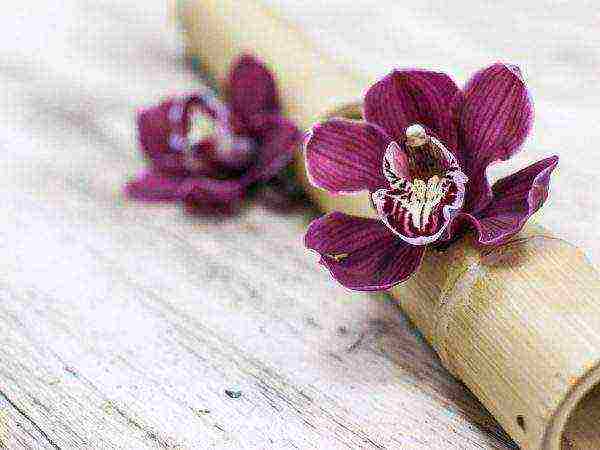
We fertilize the soil regularly
Before transplanting, carefully remove the flower and clean it from the substrate. Place the plant in a pot, cover the roots with substrate and bark, and put moss on top, it will retain moisture in the soil. The transplant is carried out only in the dormant stage or immediately after flowering. The orchid will take a little time to adapt.
It is important to fertilize the soil in a timely manner. Any flower shop sells a mixture that is suitable for orchids. It is used according to the instructions. The flower is fertilized during the dormant period, it is then that the plant accumulates strength for the next flowering.
Watering and humidity
Watering is necessary when the substrate dries. Use soft, settled water at room temperature.
With excessive watering, rotting of the root system is possible, and with a lack of moisture, the leaves begin to lose their elasticity and turn yellow.
The humidity in ordinary city apartments satisfies the flower. In the heating season, the air is drier than usual, so the flower needs to be sprayed more often with warm water, then it will bloom again.
Peduncle formation
The peduncle is the shoot on which the buds are formed. It is often barely distinguishable from a young root and grows in different directions.
The peduncle is formed in the axils of the leaves, has a sharp tip, on which scales are already visible. It is important not to disturb the orchid with transplants or movements during this period, and not to provoke stress.
Duration of development
The orchid blooms at home in late autumn. Sometimes, simultaneously with the peduncle, the phalaenopsis also releases a young leaf.
Flowering takes place in several stages:
- the first flower gives buds;
- after the inflorescences bloom.
The break between them is 1.5-2 months. Only an adult flower is capable of blooming long and beautifully. The small orchid has not yet gained strength to form a peduncle. Additional stimulation will harm her, the plant will die.
Drying of the peduncle
This is a natural process that indicates the end of flowering.
Watch him for a while: when all the buds are dry, the peduncle is removed. Carefully cut off the process with a sterile pruning shears, leaving a small stump at the base, treat the cut site with crushed activated carbon.
When the orchid rests and regains its strength, it will begin to bloom again.
Growth stimulation 
Know when to water and how
If the plant does not bloom for a long time, the following actions can be taken:
- Reduce watering by 2 weeks;
- Reduce temperature to 16 ° C.
After that, a peduncle appears from the sleeping bud. They also use ready-made liquids - growth stimulants, spray them according to the instructions.
Baby development
Sometimes, at the last stage of flowering, the dormant bud releases the baby.
When the baby is formed, and grows at least 3 leaves, and the same number of roots, carefully separate it from the mother plant and transplant it into a separate pot. Care for the transplanted baby in the same way as for an adult plant. After 2 years, the plant will release its first peduncle.
Disease prevention
Any disease or pest damage negatively affects the plant, so it is worthwhile to regularly carry out prevention.
Treat the flower with a special liquid - a fungicide, examine and manually remove insects or snails, prevent root rot and bacterial infections.
If the flower is sick, isolate it from other houseplants to avoid spreading the infection.
How often and for a long time orchids bloom.
THE SECRET OF THE PERMANENT FLOWER OF THE ORCHID. WHAT IS THE POWER? DIFFERENCE BETWEEN ADULTS AND YOUNG FALENOPSIS.
How the phalaenopsis orchid blooms on the north window at home
Conclusion
Many factors affect how long the Phalaenopsis orchid blooms at home. But there are no seemingly impossible requirements among them. Most often, if the conditions created are quite satisfactory, then the orchid will bloom even on the windowsill.
Similar articles
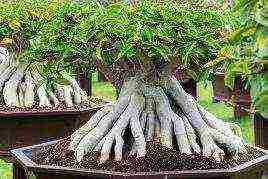
Reviews and comments


